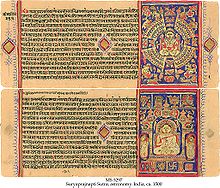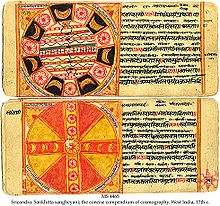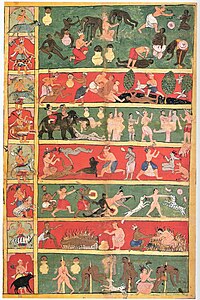From Wikipedia, the free encyclopedia
Jain cosmology is the description of the shape and functioning of the physical and metaphysical Universe (loka) and its constituents (such as living, matter, space, time etc.) according to Jainism, which includes the canonical Jain texts, commentaries and the writings of the Jain philosopher-monks. Jain cosmology considers the loka, or universe, as an uncreated entity, existing since infinity, having neither beginning nor end.[1] Jain texts describe the shape of the universe as similar to a man standing with legs apart and arm resting on his waist. This Universe, according to Jainism, is broad at the top, narrow at the middle and once again becomes broad at the bottom.[2]
Mahāpurāṇa of Ācārya Jinasena is famous for this quote: "Some foolish men declare that a creator made the world. The doctrine that the world was created is ill advised and should be rejected. If God created the world, where was he before the creation? If you say he was transcendent then and needed no support, where is he now? How could God have made this world without any raw material? If you say that he made this first, and then the world, you are faced with an endless regression."
Upper World (Udharva loka) is divided into different abodes and are the realms of the heavenly beings (demi-gods) who are non-liberated souls.
Upper World is divided into sixteen Devalokas, nine Graiveyaka, nine Anudish and five Anuttar abodes. Sixteen Devaloka abodes are Saudharma, Aishana, Sanatkumara, Mahendra, Brahma, Brahmottara, Lantava, Kapishta, Shukra, Mahashukra, Shatara, Sahasrara, Anata, Pranata, Arana and Achyuta. Nine Graiveyak abodes are Sudarshan, Amogh, Suprabuddha, Yashodhar, Subhadra, Suvishal, Sumanas, Saumanas and Pritikar. Nine Anudish are Aditya, Archi, Archimalini, Vair, Vairochan, Saum, Saumrup, Ark and Sphatik. Five Anuttar are Vijaya, Vaijayanta, Jayanta, Aparajita and Sarvarthasiddhi.
The sixteen heavens in Devalokas are also called Kalpas and the rest are called Kalpatit. Those living in Kalpatit are called Ahamindra and are equal in grandeur. There is increase with regard to the lifetime, influence of power, happiness, lumination of body, purity in thought-colouration, capacity of the senses and range of clairvoyance in the Heavenly beings residing in the higher abodes. But there is decrease with regard to motion, stature, attachment and pride. The higher groups, dwelling in 9 Greveyak and 5 Anutar Viman. They are independent and dwelling in their own vehicles. The anuttara souls attain liberation within one or two lifetimes. The lower groups, organized like earthly kingdoms - rulers (Indra), counselors, guards, queens, followers, armies etc.
Above the Anutar vimans, at the apex of the universe, is the Siddhasila, the realms of the liberated souls also known as the Siddhas, the perfected omniscient and blissful beings, who are venerated by the Jains.[10].
Madhya Loka, at the centre of the universe consists of 900 yojans above and 900 yojans below earth surface. It is inhabited by:[10]
Jambūdvīpa continent has 6 mighty mountains, dividing the continent into 7 zones (Ksetra). The names of these zones are:
The lower world consists of seven hells which is inhabited by Bhavanpati demigods and the hellish beings. Hellish beings reside in the following hells -
Mahāpurāṇa of Ācārya Jinasena is famous for this quote: "Some foolish men declare that a creator made the world. The doctrine that the world was created is ill advised and should be rejected. If God created the world, where was he before the creation? If you say he was transcendent then and needed no support, where is he now? How could God have made this world without any raw material? If you say that he made this first, and then the world, you are faced with an endless regression."
Contents[hide] |
[edit] The Concept of reality – the constituents of the Universe
This Universe is made up of what Jains call six dravya or reals or substances classified as follows:- Jīva (Living Substances)
- Jīva i.e. Souls - Soul (Jīva) exists as a reality, having a separate existence from the body that houses it. It is characterised by chetana (consciousness) and upayoga (knowledge and perception).[3] Though the soul experiences both birth and death, it is neither really destroyed nor created. Decay and origin refer respectively to the disappearing of one state of soul and appearing of another state, these being merely the modes of the soul.[4]
- Ajīva (Non-Living Substances)
- Pudgala (Matter)) - Matter is classified as solid, liquid, gaseous, energy, fine Karmic materials and extra-fine matter i.e. ultimate particles. Paramāṇu or ultimate particle (atoms) is the basic building block of all matter. One of the qualities of the Paramāṇu and Pudgala is that of permanence and indestructibility. It combines and changes its modes but its basic qualities remain the same. According to Jainism, it cannot be created nor destroyed.
- Dharma-tattva (Principle of Motion) and
- Adharma-tattva (Principle of Rest) - Dharmastikāya and Adharmastikāya are distinctly peculiar to Jaina system of thought depicting the principle of Motion and Rest. They are said to pervade the entire universe. Dharma and Adharma are by itself not motion or rest but mediate motion and rest in other bodies. Without Dharmastikāya motion is not possible and without Adharmastikāya rest is not possible in universe.
- Ākāśa (Space) - Space is a substance that accommodates the living souls, the matter, the principle of motion, the principle of rest and time. It is all-pervading, infinite and made of infinite space-points.
- Kāla (Time) - Kāla is a real entity according to Jainism and all activities, changes or modifications can be achieved only through the progress of time.
[edit] Time cycle
According to Jainism, time is beginningless and eternal. The Kālacakra, the cosmic wheel of time, rotates ceaselessly. The wheel of time is divided into two half-rotations, Utsarpiṇī or ascending time cycle and Avasarpiṇī, the descending time cycle, occurring continuously after each other.[5] Utsarpiṇī is a period of progressive prosperity and happiness where the time spans and ages are at an increasing scale, while Avsarpiṇī is a period of increasing sorrow and immorality with decline in timespans of the epochs. Each of this half time cycle consisting of innumerable period of time (measured in Sagaropama and Palyopama years)[note 1] is further sub-divided into six aras or epochs of unequal periods. Currently, the time cycle is in avasarpiṇī or descending phase with the following epochs.[6]| Name of the Ara | Degree of happiness | Duration of Ara | Average Height of People | Average Lifespan of People |
| Suṣama-suṣamā | Utmost happiness and no sorrow | 400 trillion sāgaropamas | Six Miles Tall | Three Palyopama Years |
| Suṣamā | Moderate happiness and no sorrow | 300 trillion sāgaropamas | Four Miles Tall | Two Palyopama Years |
| Suṣama-duḥṣamā | Happiness with little sorrow | 200 trillion sāgaropamas | Two Miles Tall | One Palyopama Years |
| Duḥṣama-suṣamā | Sorrow with little happiness | 100 trillion sāgaropamas | 1500 Meters | 705.6 Quintillion Years |
| Duḥṣamā | Sorrow | 21,000 Years | 6 Feet | 130 Years Maximum |
| Duḥṣama- duḥṣamā | Extreme sorrow and misery | 21,000 Years | 1 Hatha | 16-20 Years |
- Suṣama-suṣamā - During the first ara of the Avsarpini, people lived for three palyopama years. During this ara people were on average six miles tall. They took their food on every fourth day; they were very tall and devoid of anger, pride, deceit, greed and other sinful acts. Various kinds of the kalpa trees fulfilled their wishes and needs like food, clothing, homes, entertainment, jewels etc.
- Suṣamā - During the second ara the people lived for two palyopama years. During this ara people were on average 4 miles tall. They took their food at an interval of three days, but the kalpa trees supplied their wants, less than before. The land and water became less sweet and fruitful than they were during the first ara.
- Suṣama-duḥṣamā - During the third ara, the age limit of the people became one palyopama year. During this are people were on average 2 miles tall. They took their food on every second day. The earth and water as well as height and strength of the body went on decreasing and they became less than they were during the second ara. The first three ara the children were born as twins, one male and one female, who married each other and once again gave birth to twins. On account of happiness and pleasures, the religion, renunciation and austerities was not possible. At the end of the third ara, the wish-fulfilling trees stopped giving the desired fruits and the people started living in the societies. The first Tirthankara, Ṛṣabhdeva was born at the end of this ara. He taught the people the skills of farming, commerce, defence, politics and arts(intotal 72 arts for men and 64 arts for women) and organised the people in societies. That is why he is known as the father of human civilisation.
- Duḥṣama-suṣamā - During the fourth ara, people lived for 705.6 Quintillion Years. During this are people were on average 1500 Meters tall. The fourth ara was the age of religion, where the renunciation, austerities and liberation was possible. The 63 Śalākāpuruṣas, or the illustrious persons who promote the Jain religion, regularly appear in this ara. The balance 23 Tīrthaṅkars, including Lord Māhavīra appeared in this ara. This ara came to an end 3 years and 8 months after the nirvāṇa of Māhavīra.
- Duḥṣama - According to Jain cosmology, currently we are in the 5th ara. As of 2011, exactly 2,535 years have elapsed and 18,465 years are still left. It is an age of sorrow and misery. The maximum age a person can live to in this ara is 130 years. The maximum height a person can be in this ara is six feet. No liberation is possible, although people practice religion in lax and diluted form. At the end of this ara, even the Jain religion will disappear, only to appear again with the advent of 1st Tirthankara in the next cycle.
- Duḥṣama - duḥṣama - The sixth ara will be the age of intense misery and sorrow, making it impossible to practice religion in any form. The age, height and strength of the human beings will decrease to a great extent. In this ara people will live for no more than 16–20 years. This trend will start reversing at the onset of utsarpiṇī kāl.
[edit] Jain cosmology
The early Jains contemplated the nature of the earth and universe and developed a detailed hypothesis on the various aspects of astronomy and cosmology. According to the Jain texts, the universe is divided into 3 parts:[9]- Urdhva Loka – the realms of the gods or heavens
- Madhya Loka – the realms of the humans, animals and plants
- Adho Loka – the realms of the hellish beings or the infernal regions
- Sūryaprajñapti – Treatise on Sun
- Jambūdvīpaprajñapti - Treatise on the island of Roseapple tree; it contains a description of Jambūdvī and life biographies of Ṛṣabha and King Bharata
- Candraprajñapti - Treatise on moon
- Trilokasāra – Essence of the three worlds (heavens, middle level, hells)
- Trilokaprajñapti – Treatise on the three worlds
- Trilokadipikā – Illumination of the three worlds
- Tattvārthasūtra – Description on nature of realities
- Kṣetrasamasa – Summary of Jain geography
- Bruhatsamgrahni – Treatise on Jain cosmology and geography
[edit] Urdhva Loka, the upper world
Upper World is divided into sixteen Devalokas, nine Graiveyaka, nine Anudish and five Anuttar abodes. Sixteen Devaloka abodes are Saudharma, Aishana, Sanatkumara, Mahendra, Brahma, Brahmottara, Lantava, Kapishta, Shukra, Mahashukra, Shatara, Sahasrara, Anata, Pranata, Arana and Achyuta. Nine Graiveyak abodes are Sudarshan, Amogh, Suprabuddha, Yashodhar, Subhadra, Suvishal, Sumanas, Saumanas and Pritikar. Nine Anudish are Aditya, Archi, Archimalini, Vair, Vairochan, Saum, Saumrup, Ark and Sphatik. Five Anuttar are Vijaya, Vaijayanta, Jayanta, Aparajita and Sarvarthasiddhi.
The sixteen heavens in Devalokas are also called Kalpas and the rest are called Kalpatit. Those living in Kalpatit are called Ahamindra and are equal in grandeur. There is increase with regard to the lifetime, influence of power, happiness, lumination of body, purity in thought-colouration, capacity of the senses and range of clairvoyance in the Heavenly beings residing in the higher abodes. But there is decrease with regard to motion, stature, attachment and pride. The higher groups, dwelling in 9 Greveyak and 5 Anutar Viman. They are independent and dwelling in their own vehicles. The anuttara souls attain liberation within one or two lifetimes. The lower groups, organized like earthly kingdoms - rulers (Indra), counselors, guards, queens, followers, armies etc.
Above the Anutar vimans, at the apex of the universe, is the Siddhasila, the realms of the liberated souls also known as the Siddhas, the perfected omniscient and blissful beings, who are venerated by the Jains.[10].
[edit] Madhya Loka, the middle world
- Jyotishka devas (luminous gods) - 790 to 900 yojans above earth
- Human, Tiryanch (Animals, birds, plants) on the surface
- Vyantar devas (Intermediary gods)- 100 yojan below the ground level
-
-
Continent/ Island Ocean Jambūdvīpa Lavanoda (Salt - ocean) Ghatki Khand Kaloda (Black sea) Puskarvardvīpa Puskaroda (Lotus Ocean) Varunvardvīpa Varunoda (Varun Ocean) Kshirvardvīpa Kshiroda (Ocean of milk) Ghrutvardvīpa Ghrutoda (Butter milk ocean) Ikshuvardvīpa Iksuvaroda (Sugar Ocean) Nandishwardvīpa Nandishwaroda
-
- Bharat Kshetra
- Mahavideh Kshetra
- Airavat Kshetra
- Ramyak
- Hairanyvat Kshetra
- Haimava Kshetra
- Hari Kshetra
[edit] Adho Loka, the lower world
Main article: Naraka (Jainism)
| Part of a series on Jain philosophy |
 |
Concepts
Anekāntavāda ·Syādvāda · Nayavāda · Jain Cosmology ·Ahimsa ·Karma ·Dharma ·Nirvana ·Kevala Jñāna ·Mokṣa ·Dravya (Six substances) ·Navatattva (Nine or seven categories) |
Persons
AncientKundakunda · Samantaniggbhadra Umāsvāti or Umāsvāmi ·Siddhasena Divākara · Medieval Aklanka ·Haribhadra ·Hemacandra · Mānikyanandi · Vidyānandi · Prabhācandra ·Yaśovijaya · Modern Kanji Swami ·Pt. Sukhlāl · Dr. Mahendrakumār Nyāyācārya |
- Ratna prabha-dharma.
- Sharkara prabha-vansha.
- Valuka prabha-megha.
- Pank prabha-anjana.
- Dhum prabha-arista.
- Tamah prabha-maghavi.
- Mahatamah prabha-maadhavi
[edit] Śalākāpuruṣas- The deeds of the 63 Illustrious Men
Main article: Salakapurusa
During the each motion of the half-cycle of the wheel of time, 63 Śalākāpuruṣa or 63 illustrious men, consisting of the 24 Tīrthaṅkaras and their contemporaries regularly appear.[14] The Jain universal or legendary history is basically a compilation of the deeds of these illustrious men. They are categorised as follows :-- 24 Tīrthaṅkaras – The 24 Tīrthaṅkaras or the ford makers appear in succession to activate the true religion and establish the community of ascetics and laymen.
- 12 Chakravartīs – The Chakravartīs are the universal monarchs who rule over the six continents.
- 9 Baladevas and 9 Vāsudevas or Nārāyaṇas (heros) – Baladeva and Vāsudeva are half brothers who jointly rule over three continents.
- 9 Prativāsudevas (anti-heros) – They are anti-heros who are ultimately killed by the Vāsudevas.
- 9 Naradas.
- 11 Rudras.
- 24 Kamdevas.
- 24 Fathers of the Tirthankaras.
- 24 Mothers of the Tirthankaras.
- 14 Kulakaras
[edit] Notes
- ^ As per the Jain cosmology Sirsapahelika is the highest measurable number in Jainism which is 10^194 years. Higher than that is palyopama (pit measured years) which is explained by an analogy of a pit. Accordingly, a hollow pit of 8 x 8 x 8 miles tightly filled with hair particles of seven day old newly born. [A single hair form the above cut into eight pieces seven times = 20,97,152 Particles]. 1 Particle emptied after every 100 years, the time taken to empty the whole pit = 1 Palyopama. (1 Palyopama = countless years.) Hence palyopama is at least 10^194 years. Sagrapoma is 10 Quadrillion Palyopama, that means a Sagrapoma is more than 10^210 Years
[edit] References
- ^ “This universe is not created nor sustained by anyone; It is self sustaining, without any base or support” “Nishpaadito Na Kenaapi Na Dhritah Kenachichch Sah Swayamsiddho Niradhaaro Gagane Kimtvavasthitah” [Yogaśāstra of Ācārya Hemacandra 4.106] Tr by Dr. A. S. Gopani
- ^ See Hemacandras description of universe in Yogaśāstra “…Think of this loka as similar to man standing akimbo…”4.103-6
- ^ Ācārya Kundakunda, Pañcāstikāyasāra, Gatha 16
- ^ Ācārya Kundakunda, Pañcāstikāyasāra, Gatha 18
- ^ Jaini (1998)
- ^ Glasenapp (1999) Pp. 271-272
- ^ Glasenapp (1999) Pp.272
- ^ Dundas (1999) p.40
- ^ a b Shah, Natubhai (1998). p. 25
- ^ a b c Schubring, Walther (1995)Pp. 204-246
- ^ CIL. "Indian Cosmology Reflections in Religion and Metaphysics". Ignca.nic.in. http://ignca.nic.in/ps_04016.htm. Retrieved 2012-02-25.
- ^ http://www.fas.harvard.edu/~pluralsm/affiliates/jainism/workshop/Jain%20Geoghaph.PDF
- ^ Journal of the Asiatic Society of Bengal - Asiatic Society of Bengal - Google Books. Books.google.com. http://books.google.com/books?id=WAHgAAAAMAAJ&pg=RA1-PA504&lpg=RA1-PA504&dq=jain+meru+two+sun+moon&source=bl&ots=yB5CnT3akQ&sig=nkJHEnWRk73qGIqqvBQsu6vLn0o&hl=en&ei=hSmtTPfICJGusAOMouDfDA&sa=X&oi=book_result&ct=result&resnum=9&ved=0CDgQ6AEwCA#v=onepage&q=jain%20meru%20two%20sun%20moon&f=false. Retrieved 2012-02-25.
- ^ Jaini, Padmanabh (1998)
[edit] Bibliography
- Dundas, Paul; John Hinnels ed. (2002). The Jains. London: Routledge. ISBN 0-415-26606-8.
- Glasenapp, Helmuth von; (Tr.) Shridhar B. Shrotri (1999) (in English, translated from German). Jainism: An Indian Religion of Salvation. Delhi: Motilal Banarsidass Publ. ISBN 81-208-1376-6.
- Gopani, A. S.; Surendra Bothara ed. (1989). Yogaśāstra (Sanskrit) of Ācārya Hemacandra. Jaipur: Prakrit Bharti Academy.
- Jaini, Padmanabh (1998). The Jaina Path of Purification. New Delhi: Motilal Banarsidass. ISBN 81-208-1578-5.
- Nayanar, Prof. A. Chakravarti (2005). Pañcāstikāyasāra of Ācārya Kundakunda. New Delhi: Today & Tomorrows Printer and Publisher. ISBN 81-7019-436-9.
- Schubring, Walther (1995). "Cosmography". In (ed.) Wolfgang Beurlen. The Doctrine of the Jainas. Delhi: Motilal Banarsidass Publ.. ISBN 81-208-0933-5.
- Shah, Natubhai (1998). Jainism: The World of Conquerors. Volume I and II. Sussex: Sussex Academy Press. ISBN 1-898723-30-3.
[edit] See also
| ||||||||||||||
| ||










No comments:
Post a Comment